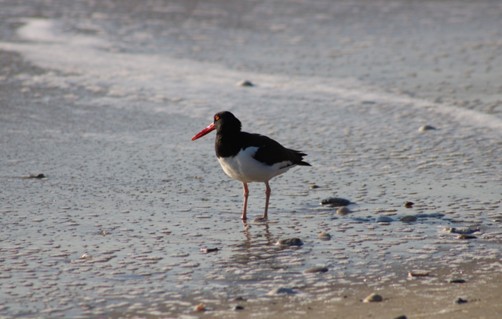By Meadow Maturen, Biological Science Technician at Cape Hatteras National Seashore
As Biological Science Technicians, we spend our time monitoring and protecting a variety of target species here on the beaches of Cape Hatteras National Seashore (Seashore). Our responsibilities as members of the Resource Management Division not only include sea turtle nest monitoring, but shorebird nesting as well. Piping plover, least terns, black skimmers, gull-billed terns, and common terns are several of the target species we spend our time observing, but the American oystercatcher is one of the more noticeable and striking shorebirds that we monitor on this busy Seashore.
Characteristics
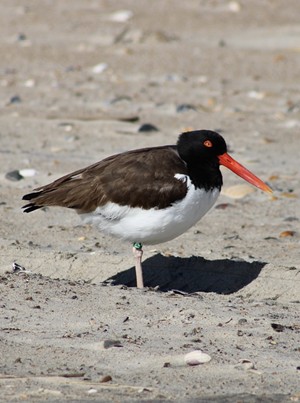
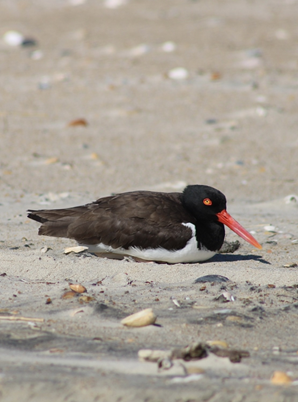
American oystercatchers (Haematopus palliatus) are easily recognizable by their eclectic colors and unique characteristics. These shorebirds have extensive red-orange bills perfectly suited for shellfish foraging, and their plumage consists of a white underbelly with darker coloring on the head and back. Contrasted against the black plumage on their head are vibrant yellow eyes outlined in a ring of orange. A black pupil is centered in the yellow iris, occasionally accompanied by an additional black eye fleck more notably prominent in females.
Diet
American oystercatchers are appropriately named for their preferred diet of shellfish and other small creatures inhabiting the foreshore. Their substantial red bill allows them to dig in the shallow, wet sand after a wave recedes and break into the shells of small mollusks to acquire their meal. On the Seashore, they can frequently be seen foraging for mole crabs on the foreshore, the area between the low and high tide lines.
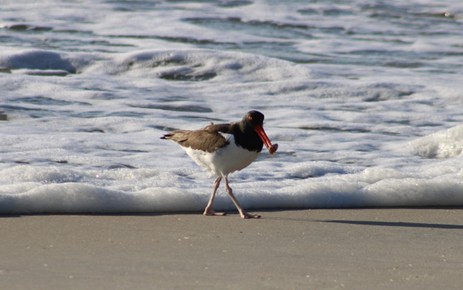
Nesting
Seashore beaches provide ideal habitat for American oystercatchers to nest. This species, like many other shorebirds, nests in shell beds or small dunes away from the danger of the high tide line. These birds will find a mate and begin scraping, or kicking out a small indentation in the sand, in search of a place on the beach perfect for their nest. The female will lay a full clutch size of 3-4 eggs, and both parents will take turns incubating for approximately 24-29 days.
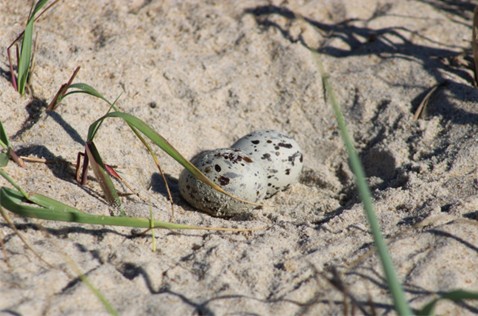
Chicks
As these shorebirds carefully and diligently tend to their nest for the duration of the incubation period, the odds are stacked against them with a high risk of depredation by coyote, opossum, racoon, and other predators as well as nest failure from harsh storms and habitat loss. If the nest can survive all these obstacles and more, the baby chicks finally hatch. American oystercatcher chicks are semi-precocial, meaning they are able to start roaming not long after they hatch. Frequently, one parent will brood the chicks while the other will return with food from the foreshore for the chicks to eat. Fledging occurs when the chicks can fly approximately 30 meters or around 35+ days after they hatch.
Banding
A spotting scope or binoculars can be used to see colored bands around the upper legs of some of these birds. These bands help the Seashore’s Biological Science Technicians and other organizations keep track of individual American oystercatchers. The color indicates the state in which the bird was banded, and the letter/number combination helps identify the specific individual for data collection. This allows age, breeding pairs, nesting grounds, chicks, and other information to be collected according to each individual bird, contributing to studies aimed at protecting this threatened species.
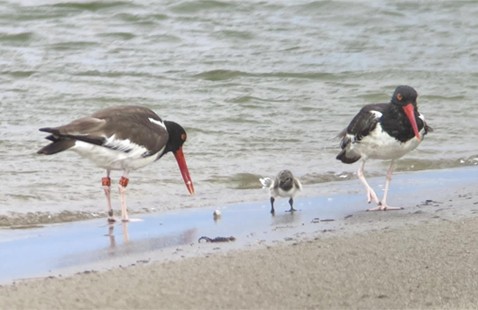
Protection and Conservation
The American oystercatcher is one of the several target species the Resource Management Division monitors and protects on the Seashore. These birds are listed as a North Carolina species of special concern and are therefore a daily part of our shifts as Biological Science Technicians. When an American oystercatcher pair exhibits breeding behavior and subsequently lays a nest, the part of the Seashore around the breeding activity will be designated as a resource protection area. These buffers around the nest allow the birds to raise their chicks with minimal human interference, permitting these birds one less obstacle to face when raising their young. The public can help protect American oystercatchers and other nesting shorebirds by keeping dogs leashed and respecting the boundaries of the resource protection areas. Educating one another about this protected species can not only assist in their overall support and protection but can allow people to garner an appreciation for this exquisite bird that inhabits the Seashore.
About Meadow
Meadow Maturen is a Biological Science Technician on Cape Hatteras National Seashore. This is her third season working for the National Park Service on Hatteras Island, and she greatly enjoys her work with wildlife by the ocean. She loves learning new things about wildlife biology and conservation efforts aimed at protecting threatened species. In her free time she enjoys traveling, exploring nature, playing guitar, and spending time by the ocean.

